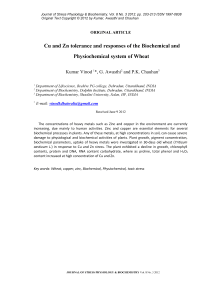Cu and Zn tolerance and responses of the biochemical and physiochemical system of wheat
Автор: Kumar Vinod, Awasthi G., Chauchan P.K.
Журнал: Журнал стресс-физиологии и биохимии @jspb
Статья в выпуске: 3 т.8, 2012 года.
Бесплатный доступ
The concentrations of heavy metals such as Zinc and copper in the environment are currently increasing, due mainly to human activities. Zinc and copper are essential elements for several biochemical processes in plants. Any of these metals, at high concentrations in soil, can cause severe damage to physiological and biochemical activities of plants. Plant growth, pigment concentration, biochemical parameters, uptake of heavy metals were investigated in 30-days old wheat (Triticum aestivum L.) in response to Cu and Zn stress. The plant exhibited a decline in growth, chlorophyll content, protein and DNA, RNA content carbohydrate, but proline, total phenol and H2O2 content increased at high concentration of Cu and Zn.
Wheat, copper, zinc, biochemical, physiochemical, toxic stress
Короткий адрес: https://sciup.org/14323664
IDR: 14323664
Текст научной статьи Cu and Zn tolerance and responses of the biochemical and physiochemical system of wheat
The metals like cobalt, iron, manganese, copper and zinc are essential for plant life but are required in a very small or trace amounts and become toxic at higher concentrations. When heavy metals are accumulated in excess in plant tissues, these may cause alteration in various physiological processes such as transpiration, photosynthesis and photosynthetic electron transport, biosynthesis of chlorophyll as well as cell membrane integriety (Jayakumar and Jaleel 2009; Hussain et al., 2010) Accumulation of metals and their toxic effects through food chain can lead to serious ecological and health problem (Malik 2004). Zinc is an essential element for several biochemical processes, such as cytochrome and nucleotide synthesis, auxin metabolism, chlorophyll production, enzyme activation and membrane integrity (Benett, 1993; Marschner, 1995). Zinc is an important limiting factor in sustainable crop production in deficit soils (Çakmak et al., 1996; Rengel and Graham, 1995). Zinc toxicity also induces chlorosis in young leaves, and this has been suggested to result from a Zn-induced Fe or Mg deficiency, based on the fact that the three metals have similar ion radii (Marschner 1995). Copper is also one of the essential micronutrients for plant growth. It is involved in numerous physiological functions as a component of several enzymes, mainly those which participate in electron flow, catalyze redox reactions in mitochondria and chloroplasts (Harrison et al., 1999; Hansch and Mendel, 2009). Excess copper can cause chlorosis, inhibition of root growth and damage to plasma membrane permeability, leading to ion leakage (Ouzounidou et al., 1992; Berglund et al., 2002; Bouazizi et al., 2010). Thus, the aim of the present study was to determine the effect of copper and zinc on wheat plant at different concentration.
MATERIALS AND METHODS
The study was conducted on VL-719 variety of wheat. Seeds were obtained from GB Pant Nagar Agricultural University and were grown in the pots (30 cm in diameter, 15cm in depth) and filled with garden 8 kg soil (pH value 7.12, organic matter content 13.6 ppm, Cu 14 ppm and Zn 98 ppm). In the present study we wanted to determine Cu and Zn tolerance of wheat at low concentration (1g i.e.150ppm, 2g i.e. 280ppm) and at high concentration ( 5g i.e. 600ppm) in 8 kg soil. The Cu and Zn treatment were given in concentrations viz 1g, 2g and 5g. Untreated garden soil of one pot was taken as control. Experiment was conducted in January, 2012. Sampling was done after 30 days for biochemical studies.
Estimation of metal concentration and height of wheat plants grown on treated soil
Heavy metal analysis is carried out using Ashok Kumar method (2009). Heavy metal analyses were carried out using atomic absorption spectrophotometer at Wadia Institute of Himalayan Geology (WIHG), Dehradun. The above-ground height of each treated and control plants were measured (average was taken of all the readings).
Measurement of chlorophyll contents
Measurement of chlorophyll contents were done by using the spectrophotometric method (Chen, 2002). Then the photo densities were measured under the 663 nm, 646 nm, and 470 nm wavelengths. The chlorophyll concentration of fresh leaves was calculated using the formulae given Lichtenthaler and Wellburn (1983).
Estimation of proline
Proline content was determined using a colorimetric method (Asgharipour et al., 2011). The photometric absorbance of the Toluene extract was read at 520 nm. Contents were calculated to ηg g-1 dry matter.
Measurement of soluble protein content
Estimation of total soluble proteins was done by the method of Bradford (1976). The protein concentrations were determined by using bovine serum albumin as standard. Absorbance was recorded photometrically at 595 nm.
Estimation of total soluble sugars
Soluble Carbohydrate content was measured by M.R. Asgharipour et al., (2011) method. The supernatants were used as samples to determine total soluble Carbohydrate. Estimation of carbohydrates of sample by phenol-Sulphuric acid assay (Sturgeon, 1990).
Estimation of total Phenol
Total phenols were recorded by McDonald et al., (2001) methods. Total phenol contents were expressed in terms of gallic acid equivalent (mg/g of dry mass), which is used as a reference compound.
Estimation of Hydrogen peroxide (H2O2)
Hydrogen peroxide in the plant samples was determined by the method of Velikova et al. , (2000).
Statistical Analysis
Each result shown tables was the mean of at least three replicated treatments. The significance of differences between treatments was statistically evaluated by ANOVA.
RESULTS AND DISCUSSION
In the present study, exposure to heavy metals (Cu and Zn) its responses at different parameters of VL-719 variety of Wheat: Plant height, chlorophyll a, chlorophyll b, carotenoid, proline, protein, carbohydrate, total phenol, H 2 O 2 , DNA and RNA content. Exposure of wheat to high concentration of Zn and Cu decreased chlorophyll a, chlorophyll b, carotenoid, protein, carbohydrates, DNA and RNA content and increased the proline, Phenol and H 2 O 2 as compared with controls.
Absorption of Zn and Cu by wheat plant
After 30 days of growth the accumulation of Zn and Cu given in the table 1 with compared to the control. Wheat plant absorbed less Zn as compared to Cu. The concentrations of Zn and Cu were 80 and 21 ppm, respectively at 5g treated soil (Table 1). The rate of accumulation of Zn and Cu was higher at higher concentrations of metals.
Effects on shoot height and root length of the wheat plant
With the increasing concentration of Zn in the soil, the shoot and root length increased more significantly than the Cu (Table 1). Significant increase in shoot and root length was observed with the increase of Zn concentrations. But at high concentration there is no significance change in the shoot and root length of wheat plant due to Zn toxicity. Cu shows no significance effect on length at low concentration but high concentration it decreased. These results supported the results of
Kaya et al. , (2002) zinc, increased plant height via increasing internodes distances. Our results also supported the results of Bameri et al. , (2012) Zn significantly increased the wheat plant height. Xu et al., (2005) reported that the plant height, leaf number, elongated internode number and heading date of rice plants were not affected at soil Cu levels below 200 mg/kg, but affected and significantly decreased the above mentioned parameters at and above 400 mg/kg
Effects on leaf pigment contents
Various abiotic stresses decrease the chlorophyll content in plants (Ahmad et al., 2007). It was shown that the wheat plants treated with Cu and Zn exhibited inhibitory effect with respect to chlorophyll a, chlorophyll b and carotenoid contents at high concentrations of Cu and Zn compared with controls (Table 2). At low concentration of Zn the chlorophyll a, chlorophyll b and carotenoid contents increased. Copper was more toxic than Zn in terms of chlorophyll inhibition. Our results of decrease in chlorophyll content corroborated with the findings of Bassi and Sarma (1993) who found that Copper was more toxic than Zn in terms of chlorophyll inhibition in wheat seedlings. The loss in chlorophyll content can consequently lead to disruption of photosynthetic machinery. The chlorophyll and carotenoid contents of wheat leaves seedlings increase up to 1g of zinc level. Further increase in zinc level significantly decreased the chlorophyll and corotenoid content. The increased chlorophyll and carotenoid content was obviously due to zinc at low level act as a structural and catalytic components of proteins, enzymes and as cofactors for normal development of pigment biosynthesis (Balashouri and Prameeladevi, 1995). The excess zinc treatment brought about a marked depression in photosynthetic pigment in plants. It might be due to excess supply of zinc resulting in interference with the synthesis of chlorophyll (Manivasagaperumal et al., 2011).
Effects on leaf Proline content
Proline, an amino acid, is well known to get accumulated in wide variety of organisms ranging from bacteria to higher plants on exposure to abiotic stress (Saradhi et al., 1993). Our results indicate that accumulation of proline increases with increasing Cu and Zn concentration (Table 2). The Proline content was higher in the Plants treated with Cu than in the Zn treated plants. Our results of increased in proline content corroborated with the findings of Bassi and Sarma (1993) who also found that the Copper proved to be a stronger inducer of proline accumulation than Zn in wheat seedlings. It has been determined that, as a response to heavy metals generated stress, plants increase their proline and abscisic acid (Zengin and Kirbag 2007) Proline is known to accumulate under heavy metal exposure and considered to involve in stress resistance. Proline increases the stress tolerance of the plants through such functions as osmoregulation, the protection of enzymes against denaturation, and the stabilization of protein synthesis (Kuznetsov and Shevyakova, 1997).
Effects on total sugar content
Heavy metals also modified the carbohydrate accumulation in wheat leaves (Fig.1). At high Cu and Zn concentration significantly decreased the Carbohydrate levels measured in the leaves. The total soluble sugar content was lower in the Plants treated with Cu than in the Zn treated plants. Our results of decreased in total sugar content supported the findings of Singh et al. , (2007) that sugar contents were significantly decreased in all
207 the doses of Cu on both 14th and 21st days Manivasagaperumal et al., (2011) reported that Sugar and starch content showed a decreasing trend with progressive increase in zinc content in cluster Bean. The observed decline in total sugar with respect to the high level of zinc may be due to its role on the enzymatic reactions related to the cycles of carbohydrate catabolism (Rabie et al. , 1992).
Effects on leaf Protein content
Our results indicate that of protein content decreases with increasing Cu and Zn concentration (Fig. 2). The protein content was lower in the plants treated with Cu than in the Zn treated plants and control plants. Our results favoured the results of Manivasagaperumal et al., (2011) who found that Amino acid and protein content were high at lower concentrations of zinc (10 and 25 mgl-l) further the values decreased with an increace in Zn level. The inhibition of excess zinc in amino acid and protein might be due to binding of metals with the sulfhydryl group of protein and causing deleterious effect in the normal protein form. Protein was appreciably reduced in wheat at the higher concentration of copper exposure Singh et al. , (2007). It showed that excessive Cu reduced protein amount of many plant species (Chen et al. , 2001; Singh et al. , 2007).
Effects on leaf total Phenol
In table 3 results indicated that at high concentration of Cu and Zn markedly increased the phenolic content of wheat leaves. Our results supported the results of Hamid et al., (2010) who found that phenolic content of plants were increasing with increasing levels of heavy metal Ganeva and Zozikova (2007) reported that the content of free phenols was found to increase in wheat with increasing Cu2+ concentration in the medium.
Effects on Hydrogen peroxide (H2O2)
Table 3 shows that the hydrogen peroxide level was high at high concentration of Zn and Cu in this cultivar. At low concentration of the Zn and Cu there was no significance increase in H 2 O 2 level. Our results supported the results of Singh and Malik (2011) who reported that enhancement in Hydrogen peroxide content as a response to heavy metal stress in Brassica juncea seedlings. Hatata and Abdel-Aal (2008) also reported that the amount of hydrogen peroxide a significant increase in leaves and roots of sunflower plant treated with heavy particularly at higher concentrations.
Effect on Nucleic acid content
DNA and RNA content were low at high concentration of Zn and Cu in this cultivar. At low concentration of the Zn the DNA content increase, RNA content decreased. Our result supported the results of Dhankhar and Solanki (2011) increase in DNA content with increase in zinc concentration in Vigna mungo (L.). At low Cu concentration there was no significance increase in DNA and RNA content. Our results of decline in DNA and RNA content supported the results of Jana and Choudhuri (1984) who also found a decrease in DNA and RNA content with heavy metal stress Dhankhar and Solanki (2011) reported that decrease in RNA content with increase in copper and zinc concentration in Vigna mungo (L.). The metals such as Cu, Ni, Cd and Pb have been reported to decrease RNA synthesis and to activate ribonuclease (RNase) activity, leading to further decrease in RNA content (Schmidt, 1996). Prasad and Strzalka (2002) have been reported in plants that due to heavy metals (Cd, Cu, Cr, Ni, Pb, Hg, Pt and Zn) stress, there is reduced efficiency of DNA synthesis, weaker DNA protection from damaged chromatin protein (histone) and increased deoxribonuclease (DNase) activity.
Table 1. Cu and Zn accumulation and wheat plant shoot and root length after 30 days
|
Treatment |
Cu (ppm) |
Plant Height |
Root Length |
Wheat plant |
Zn (ppm) |
Plant Height |
Root Length |
|
1 g Cu |
16 |
26.0±1.5 |
6.21±1.6 |
1 g Zn |
69 |
26.1±1.7 |
6.76±1.2 |
|
2g Cu |
17 |
24.4±1.9 |
6.26±1.8 |
2g Zn |
72 |
28.7±1.3 |
6.82±1.4 |
|
5 g Cu |
21 |
23.9±1.6 |
6.30±1.9 |
5 g Zn |
80 |
28.9±1.8 |
6.85±1.9 |
|
Control |
12 |
25.4±1.9 |
5.13±1.8 |
Control |
50 |
25.4±1.9 |
5.13±1.8 |
Table 2. Effects of Cu and Zn in separate treatments on leaf pigments of wheat Plant
|
Treatment |
Chlorophyll (a) (mg/g) |
Chlorophyll (b) (mg/g) |
Carotenoid (mg/g) |
Proline (µ mol/g) |
|
1g. Cu |
0.600± 0.06 |
0.524±0.05 |
0.761±0.07 |
29.46±1.87 |
|
2g Cu |
0.390±0.08 |
0.358±0.04 |
0.498±0.01 |
30.53±2.34 |
|
5g Cu |
0.312±0.06 |
0.298±0.03 |
0.201±0.03 |
33.89±1.47 |
|
1g. Zn |
0.798±0.04 |
0.683±0.06 |
0.996±0.04 |
25.47±1.94 |
|
2g. Zn |
0.609±0.01 |
0.489±0.08 |
0.753±0.03 |
27.62±1.32 |
|
5g. Zn |
0.540±0.07 |
0.419±0.07 |
0.404±0.05 |
31.76±1.94 |
|
Control |
0.775±0.07 |
0.650±0.08 |
0.964±0.06 |
23.43±1.72 |
Table 3. Effect of Cu and Zn on total Phenol and H 2 O 2
|
Treatment |
Total Phenol ( mg/g F. Wt) |
H2O2 (µ mol/g FW) |
|
1g. Cu |
1.1±0.16 |
293.13±2.13 |
|
2g Cu |
1.3±0.73 |
350.14±2.19 |
|
5g Cu |
1.7±0.21 |
522.64±1.79 |
|
1g. Zn |
1.2±0.63 |
300.00±1.34 |
|
2g. Zn |
1.6±0.26 |
365.73±1.43 |
|
5g. Zn |
1.9±0.65 |
564.33±1.10 |
|
Control |
0.9±0.01 |
289.57±2.05 |
Total carbohydrate (mg/g F.Wt)
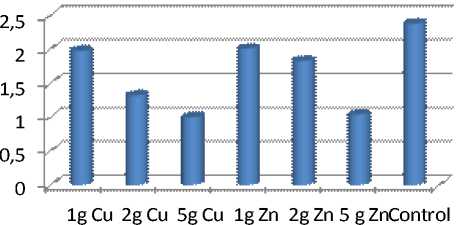
Figure 1. Effect of Cu and Zn on Carbohydrate content of wheat Plant
Total Protein (mg/g F.Wt)
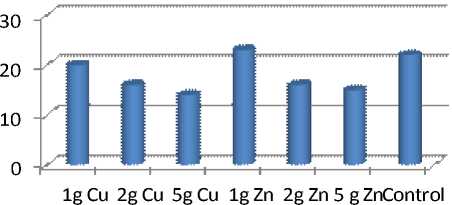
Figure 2. Effect of Cu and Zn on Protein content of wheat Plant
DNA (µg/g)
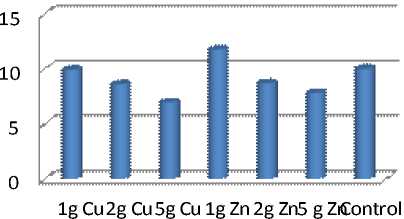
Figure 3. Effect of Cu and Zn on DNA content of wheat Plant
RNA (µg/g)
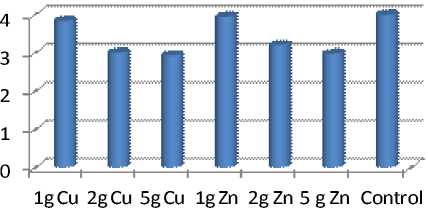
Figure 4. Effect of Cu and Zn on RNA content of wheat Plant
CONCLUSION
Conclusively, our results shows that Cu and Zn at high concentration decreased in growth, chlorophyll content, protein and DNA, RNA content, carbohydrate but proline, total phenol, H 2 O 2 content increased. Our result suggest that the presence of Cu and Zn in low concentration is good for wheat plant growth but high concentration of Cu and Zn in the soil toxic to the wheat plants resulted in growth inhibition, structure damage, a decline of physiological and biochemical activities of wheat plant.
Список литературы Cu and Zn tolerance and responses of the biochemical and physiochemical system of wheat
- Ahmad P., Sharma S., Srivastava P.S. (2007). In vitro selection of NaHCO3 tolerant cultivars of Morus alba (Local and Sujanpuri) in response to morphological and biochemical parameters. Hort. Sci. (Prague)., 34, 114-122.
- Asgharipour M.R., Khatamipour M. and Razavi-Omrani M. (2011) Phytotoxicity of Cadmium on Seed Germination, Early Growth, Proline and Carbohydrate Content in Two Wheat Verities. Advances in Environmental Biology., 5(4), 559-565.
- Balashouri, P. and Prameeladevi Y. (1995) Effect of zinc on germination, growth, pigment content and phytomass of Vigna radiata and Sorghum bicolor. J. Ecobiol., 7, 109-114.
- Bameri M., Abdolshahi R., Mohammadi-Nejad Gh., Yousefi Kh. and Tabatabaie S.M. (2012) Effect of different microelement treatment on wheat (triticum aestivum) growth and yield. Intl. Res. J. Appl. Basic. Sci., 3 (1), 219-223.
- Bassi R., Sharma S.S. (1993) Proline accumulation in wheat seedlings exposed to zinc and copper Phytochemistry., 33, 1339-1342.
- Bennett, F. (1993) Nutrient Deficiencies and Toxicities in Crop Plants (Edit), The American Phytopathological Society, USA.
- Berglund, A.H., Mike, F., Quartacci, M.F., Calucci, L.C., Navari-Izzo, F., Pinzino, C. and Liljenberg, C. (2002) Alterations of wheat root plasma membrane lipid composition induced by copper stress result in changed physicochemical properties of plasma membrane lipid vesicles. Biochimica. et Biophysica. Acta., 1564: 466-472.
- Bouazizi, H., Jouili, H., Geitmann, A. and Ferjani, E.E.I. (2010) Copper toxicity in expanding leaves of Phaseolus vulgaris L.: antioxidant enzyme response and nutrient element uptake. Ecotox. Environ. Saf., 73: 1304-1308.
- Bradford, M. (1976) A Rapid and Sensitive Method for the Quantitation of Microgram Quantities of Protein Utilizing the Principle of Protein-Dye Binding. Anal. Biochem. 72, 248-254.
- Çakmak, İ., A. Yılmaz, M. Kalaycı, H. Ekiz, B. Torun, B. Erenoğlu and H.J. Braun. (1996) Zinc deficiency as a critical problem in wheat production in central Anatolia. Plant Soil., 180: 165-172.
- Chen, C.T., Chen L.M., Lin C.C. and Kao C.H. (2001) Regulation of proline accumulation in detached rice leaves exposed to excess copper. Plant Sci., 160: 283-290.
- Chen, J.X. (2002) Plant Physiology Experimentation. Guangzhou: South China Science and Engineering University Press.
- Dhankhar R. and Solanki R. (2011) Effect of copper and zinc toxicity on physiological and biochemical parameters in Vigna mungo (L.) Hepper. International Journal of Pharma and Bio Sciences., 2(2), 553-565.
- Ganeva G. and Zozikova E. (2007) Effect Of Increasing Cu2+ Concentrations On Growth And Content Of Free Phenols In Two Lines Of Wheat (Triticum Aestivum) With Different Tolerance Gen. Appl. Plant Physiology., 33 (1-2): 75-82.
- Hamid N., Bukhari N. and Jawaid F. (2010) Physiological responses of phaseolus vulgaris to different lead concentrations. Pak. J. Bot., 42(1), 239-246.
- Hansch, R. and Mendel, R.R. (2009) Physiological functions of mineral micronutrients (Cu, Zn, Mn, Fe,Ni, Mo,B, Cl). Curr. Opin. Plant. Biol., 12: 259-266.
- Harrison, M.D., Jones, C.E. and Dameron, C.T. (1999) Copper chaperones: function structure and copper-binding properties., JBIC., 4: 145-153.
- Hatata M.M. and Abdel-Aal E.A. (2008) Oxidative Stress and Antioxidant Defense Mechanisms in Response to Cadmium Treatments. American-Eurasian J. Agric. & Environ. Sci., 4 (6), 655-669.
- Hussain K., Sahadevan K.K. and Salim N. (2010) Bioaccumulation and release of mercury in Vigna mungo (L.) Hepper seedlings. Journal of stress physiology & Biochemistry., 6(3): 56-63.
- Jana, S. and Choudhuri, M.A. (1984) Synergistic effects of heavy metal pollutants on senescence in submerged aquatic plant. Water, Air & Soil Pollution., 21(1-4), 351-357.
- Jayakumar K. and Jaleel C.H. (2009) Uptake and accumulation of cobalt in plants: a study based on exogenous cobalt in soyabean. Botany Research International., 2(4), 310-314.
- Kaya C., Higgs D., Burton A. (2000) Phosphorus and acid phosphatase enzyme activity in leaves of tomato cultivars in relation to zinc supply. Communications in Soil Science and Plant Analysis 31(19-20), 3239-3248.
- Kumar Ashok, Sharma I.K., Sharma Alka, Varshney Sarita, and Verma P.S. (2009) Heavy metals contamination of vegetable foodstuffs in Jaipur (India) EJEAFChe., 8 (2), 96-101.
- Kuznetsov, V.V. and Shevyakova N.I. (1997) Stress responses of tobacco cells to high temperature and salinity. Proline accumulation and phosphorilation of polypeptides. Physiologia Plantarum., 100: 320-326.
- Lichtenthaler, H.K. and Wellburn A.R. (1983) Determinations of total carotenoids and chlorophylls a and b of leaf extracts in different solvents. Biochemical Society Transactions., 11, 591 -592.
- Malik A. (2004) Metal bioremediation through growing cells. Chemosphere., 30: 261-278.
- Manivasagaperumal R., Balamurugan S., Thiyagarajan G., Sekar J. (2011) Effect of Zinc on Germination, Seedling Growth and Biochemical Content of Cluster Bean (Cyamopsis tetragonoloba (L.) Taub). Curr Bot., 2, 11-15.
- Marschner H. (1995) Mineral Nutrition of Higher Plants. second edition. London: Academic Press, 889pp.
- McDonald, S., Prenzler P.D., Autolovich M. and Robards K. (2001) Phenolic content and antioxidant activity of olive extracts. Food Chem.,73, 73-84.
- Ouzounidou, G., Eleftheriou E.P. and Karataglis S. (1992) Ecophysiological and ultrastructural effects of copper in Thlaspi ochroleucum (Curciferae). Can. J. Bot., 70: 947-957.
- Prasad, M.N.V. and Strzalka K. (2002) Physiology and Biochemistry of heavy metal toxicity and tolerance in plants. Dordrecht, Kluwer Academic Publishers.
- Rabie, M.H., Eleiwa M.E., Aboseoud M.A. and Khalil K.M. (1992) Effect of nickel on the content of carbohydrate and some mineral in corn and broad bean plant. J. K. A. U. Sci., 4, 37.
- Rengel, Z. and Graham R.D. (1995) Wheat cultivars differ in Zn efficiency when grown in chelate buffered nutrient solution. Plant Soil., 17(6), 307-316.
- Saradhi P., Alia, Vani B. (1993) Inhibition of mitochondrial electron transport is the prime cause behind proline accumulation during mineral deficiency in Oryza sativa. Plant Soil., 155/156(1), 465-468.
- Schmidt, W. (1996) Influence of chromium (lll) on root associated Fe (lll) reductase in Plantago lsnceolata L. J Exp. Bot., 47: 805-810.
- Singh Y. and Malik C.P. (2011) Phenols and their antioxidant activity in Brassica juncea seedlings growing under HgCl2 stress. J. Microbiol. Biotech. Res., 1 (4), 124-130.
- Singh, D., Nath K. and Sharma Y.K. (2007) Response of wheat seed germination and seedling growth under copper stress. J. Environ. Biol., 28, 409-414.
- Sturgeon, R.J. Monosaccharides. (1990) In Methods in Plant Biochemistry. Vol. 2. Carbohydrates. Ed. P.M. Dey. Academic Press, London. pp 1-37.
- Velikova, V., Yordanov I. and Edreva A. (2000) Oxidative stress and some antioxidant systems in acid rain-treated bean plants: protective roles of exogenous polyamines. Plant Sci., 151, 59-66.
- Xu Jia-kuan, Yang Lian-xin, Wang Zi-qiang, Dong Gui-chun, Huang Jian-ye1,Wang Yu-long. (2005) Effects of Soil Copper Concentration on Growth, Development and Yield Formation of Rice (Oryza sativa). Rice Science., 12(2), 125-132.
- Zengin F.K., Kirbag S. (2007) Effects of copper on chlorophyll, proline, protein and abscisic acid level of sunflower (Helianthus annuus L.) seedlings. J Environ Biol., 28(3): 561-566.

